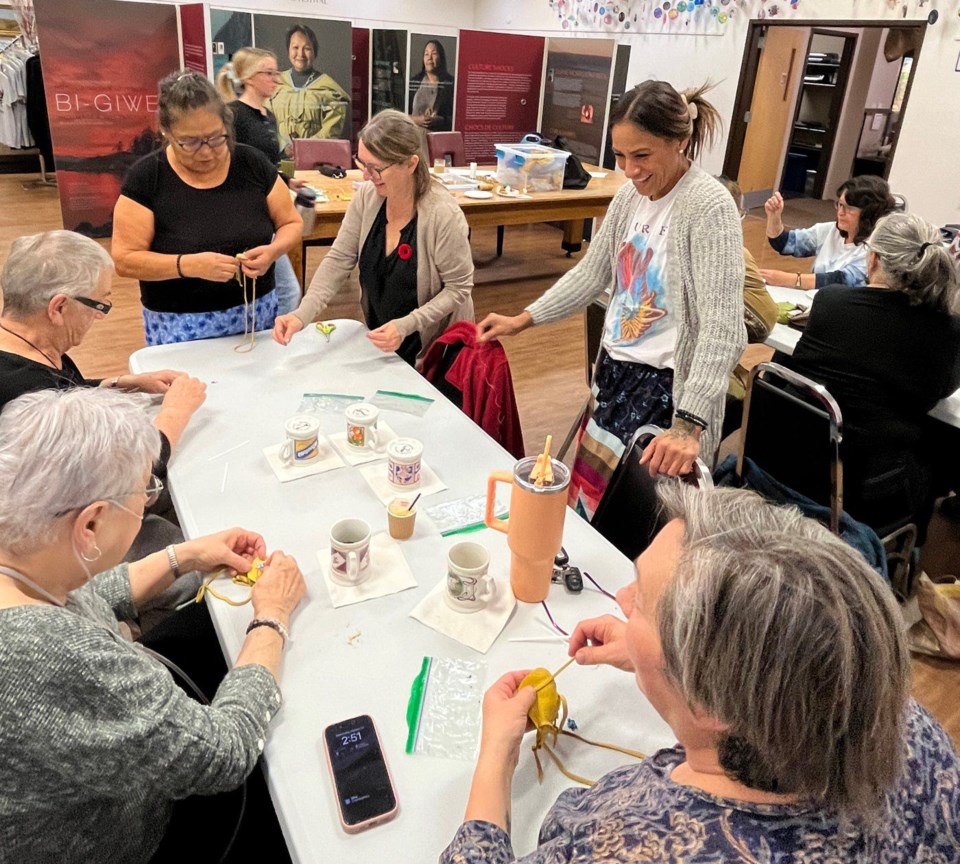SHAUNAVON — A question about what “elder” means across various cultures was an appropriate discussion for a gathering of seniors at the Oct. 30 Afternoon at the Museum, organized collaboratively between Shaunavon Age-Friendly and the Grand Coteau Heritage & Cultural Centre.
Traditional Knowledge Keeper Elouise Mosquito, of Nekaneet First Nation, along with her daughter, Iris Francis, joined 20 seniors in the museum gallery for an afternoon of sharing. Mosquito shared traditional Indigenous knowledge, led participants in a craft, creating small leather pouches and brought a delicious treat of bannock for everyone, served with chokecherry syrup or blueberry jam.
During the age-friendly event, Mosquito shared traditional stories and answered questions from attendees. When asked if there is a difference between a Traditional Knowledge Keeper and Elder, Mosquito laughs and says, “I suppose they’re similar, but I’m not ready to be called an Elder!”
It would seem that across cultures, the terms elder and senior hold certain connotations that still have underlying tones referring strictly to a person’s age rather than focusing on the positivity of the words and the wisdom and experience that comes with age. It was also noted that elder might refer to much younger people, specifically men, in some religious groups.
Mosquito went on to explain, “In our culture, an elder is generally older in age but most importantly, they are humble, compassionate and care for people.” Mosquito exudes those qualities in her interactions with people.
She and Iris were both wearing beautiful ribbon skirts which attendees noted and asked questions about. Mosquito explained, “In the past, ribbon skirts were used only for ceremonies such as sundance and round dances. Men would wear ribbons on their shirts, too, and horses would have ribbons in their manes and tails. Today, ribbon skirts are also worn as fashion.”
She also shared a story explaining the significance of turtles in Indigenous culture. Indigenous cultures refer to North America as Turtle Island, but the meaning of the turtle goes deeper. “The turtle is slow. I remember one time driving on some very muddy roads with my family; it wasn’t easy and I wasn’t sure we would make it through. My parents told me to pray to the turtle and God, as they will get you home safely. The turtle is very important in our culture.” Some of the leather pouches created by participants were adorned with turtle charms.
Mosquito and family are from the Nekaneet First Nation near Maple Creek. She emphasized that a lot has changed over the years but Nekaneet has tried to keep ceremony and language as priorities. “We try to teach our kids the language. Cree has always been an oral language and was never a written language. We will eventually lose it if it’s not being passed down.” For now, it seems that the passing of knowledge and tradition is happening.
Mosquito’s Mom passed away a few years ago, but she was also an Elder. Another generation of this family, Iris’ daughter Taneshea Francis, is also sharing knowledge with communities in the southwest. Taneshea created a visual land acknowledgement that was adopted by the Chinook Regional Library in 2022 and is displayed at all library branches in the region.
Taneshea’s artwork is accompanied by her statement on the work, “This land acknowledgement design was inspired by the spirit of the treaties, “As long as the sun shines, the grass grows, and the river flows”, as well as incorporating the infinity sign to represent the Metis Nation. This is meant to be a unique, meaningful and visual way to acknowledge the land and nations who traditionally lived here, without it just being words on a plaque on the wall which are easily missed or ignored, hopefully serving as a good conversation starter and beautiful reminder. A noteworthy design element would be the circular shape which is inspired by the Indigenous Medicine Wheel, representing the circle of life, and also ensuring that in acknowledging all the nations, none ‘come first’ in the list and that they are all equal around the circle in no particular order or hierarchy.”
There will be one more Afternoon at the Museum before the new year, on December 4. Seniors can register by contacting Kim Anderson, Age-Friendly Coordinator, at 306-294-7653 or email [email protected], or drop by the office at 420 Centre Street on Tuesdays from 9:30 a.m. to 3 p.m. or Thursdays from 1 to 3 p.m.




